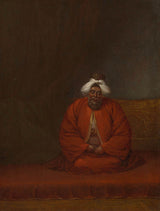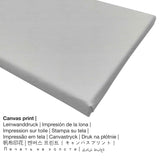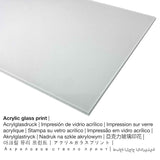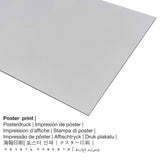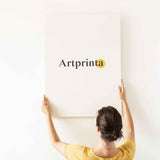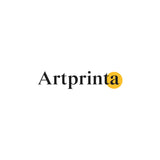Jean Baptiste Vanmour, 1727 - Mufti, onye isi nke ihe omume okpukpe - ọmarịcha nka.
Ụtụ gụnyere. Mbupu gbakọrọ na ndenye ọpụpụ.
Họrọ ngwa ngwaahịa ịchọrọ idowe n'ụlọ gị
The product dropdown menu provides you with the chance to select the size and material of your choice. Select your preferred size and material among the following options:
- Aluminom ihe eji eme ihe: An Aluminium Dibond print is a material with an outstanding depth effect. The colors are vivid and luminous in the highest definition, the fine details appear crisp, and there’s a matte appearance you can literally feel.
- Poster (akwa akwa akwa): The poster print is a printed cotton canvas with a slightly rough surface finish, that resembles the actual version of the masterpiece. Please keep in mind, that depending on the size of the canvas poster print we add a white margin 2-6cm round about the artwork, which facilitates the framing with your custom frame.
- Bipụta na iko acrylic (nke nwere ezigbo mkpuchi iko): The print on acrylic glass, often named a fine art print on plexiglass, will turn the artwork into beautiful home décor. The work of art is being custom-made thanks to the help of modern UV print technology. The great benefit of a plexiglass print is that sharp contrasts and also artwork details become more visible thanks to the granular gradation of the print.
- Mbipụta kwaaji: A canvas print, which should not be mistaken with an artwork painted on a canvas, is a digital copy applied directly on cotton canvas material. A canvas print of your favorite masterpiece will let you turn your into a large work of art as you know from galleries. Canvas Prints have the great advantage of being relatively low in weight, which implies that it is easy to hang up the Canvas print without the support of additional wall-mounts. Canvas prints are suitable for any kind of wall.
Disclaimer: We try everything in order to depict the products as accurate as possible and to display them visually on the product detail pages. Although, the colors of the print products, as well as the printing might vary marginally from the image on your device's monitor. Depending on your screen settings and the quality of the surface, not all color pigments are printed one hundret percent realistically. Given that all art prints are printed and processed manually, there might as well be slight variations in the size and exact position of the motif.
Ozi izizi gbasara nka nke ụlọ ihe ngosi nka (© - site Rijksmuseum - Rijksmuseum)
Vanmour probably painted the portrait of Abdullah Efendi (1680? -1743). This originally Greek spirit was from 1718 to the court related to the function of Seyh ül Islam and had to step down after the uprising of 1730. He was exiled, but returned silently back to Istanbul where he died in 1743. Abdullah had an impressive collection of religious legal documents and played a crucial role in the introduction of the printing press in the Ottoman Empire.
The Mufti, head of the religious affairs dị ka ihe oyiri nka
Nkà nka ochie a nwere aha The Mufti, head of the religious affairs was created by the painter Jean Baptiste Vanmour. What is more, this piece of art is included in the Rijksmuseum's digital collection dị na Amsterdam, Netherlands. The ngalaba ọha a na-enye mpempe nka site n'ikike nke Rijksmuseum.Additionally, the artwork has the following creditline: . Moreover, alignment is portrait and has an aspect ratio of 3: 4, nke pụtara na ogologo bụ 25% mkpụmkpụ karịa obosara.
Nkọwa na ọrụ nka
| Aha nke ọrụ nka: | "The Mufti, head of the religious affairs" |
| Nhazi nka: | sere |
| Nhazi nka: | nka ochie |
| Time: | 18th narị afọ |
| Emepụtara na: | 1727 |
| Ogologo afọ nka nka: | ihe dị ka afọ 290 |
| Ụlọ ihe ngosi nka / ebe: | Rijksmuseum |
| Ebe ngosi nka: | Amsterdam, Netherlands |
| Ebe nrụọrụ weebụ ihe ngosi nka: | Rijksmuseum |
| Akwụkwọ ikike nka: | ngalaba ọha |
| Site n'aka: | Rijksmuseum |
Banyere edemede a
| Nkewa bipụta: | mmepụta nka |
| Usoro mmeghari: | dijitalụ mmeputakwa |
| Produzọ mmepụta: | mbipụta dijitalụ (Mbipụta UV ozugbo) |
| Mmalite nke ngwaahịa a: | German mmepụta |
| Stockdị ngwaahịa: | mmepụta ihe na-achọ |
| Ngwaahịa were: | mgbidi gallery, mgbidi ndozi |
| Nhazi nka nka: | usoro eserese |
| Oke akụkụ: | (ogologo: obosara) 3: 4 |
| Oke onyonyo pụtara: | ogologo bụ 25% mkpụmkpụ karịa obosara |
| Akwa mmeputakwa dị: | ígwè obibi akwụkwọ (aluminium dibond), ebipụta canvas, mbipụta enyo acrylic (nwere ezigbo mkpuchi iko), mbipụta akwụkwọ mmado (akwụkwọ kwaaji) |
| Mbipụta kanvas (akwa akwa na etiti ihe ndọtị): | 30x40cm - 12x16", 60x80cm - 24x31", 90x120cm - 35x47", 120x160cm - 47x63" |
| Mbipụta iko acrylic (nwere ezigbo mkpuchi iko) nhọrọ nha: | 30x40cm - 12x16", 60x80cm - 24x31", 90x120cm - 35x47" |
| Mbipụta akwụkwọ mmado (akwụkwọ kwaaji): | 30x40cm - 12x16", 60x80cm - 24x31", 90x120cm - 35x47" |
| Mbipụta aluminom (aluminium dibond ihe) nha dị iche iche: | 30x40cm - 12x16", 60x80cm - 24x31", 90x120cm - 35x47" |
| Igwe onyonyo: | agunyeghi |
Tebụl nchịkọta ihe nkiri
| Ihe nkiri: | Jean Baptiste Vanmour |
| Aha ndị ọzọ: | Moor Jean-Baptiste van, Van Mour Jean-Baptiste, Jean-Baptiste van Mour, Vanmour Jean Baptiste, Mour, Van Moor Jean Baptiste, Jean Baptiste Van Mour, J.B. van Moor, Mour Jean-Baptiste van, Mour Jean Baptiste van, Van-Mour, Van Mour Jean Baptiste, Van Moor Jean-Baptiste, Jean Baptiste Vanmour, Jan Baptista van Mour, Vanmour Jean-Baptiste, Vanmour |
| okike nke onye nka: | nwoke |
| Obodo onye nka: | French |
| Ọrụ: | onye na-ese ihe |
| Mba onye si: | France |
| Otu nka: | nna ukwu ochie |
| Akwụsị: | 66 afọ |
| Amụrụ n'afọ: | 1671 |
| Ebe omuma: | Valenciennes, Hauts-de-France, France |
| Afọ ọnwụ: | 1737 |
| Nwuru na (ebe): | Istanbul, Istanbul, Turkey |
© Nwebiisinka - ikike ọgụgụ isi nke - www.artprinta.com (Artprinta)

